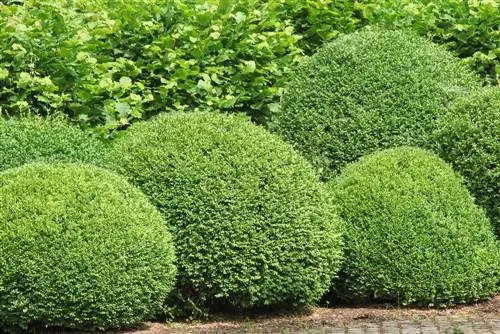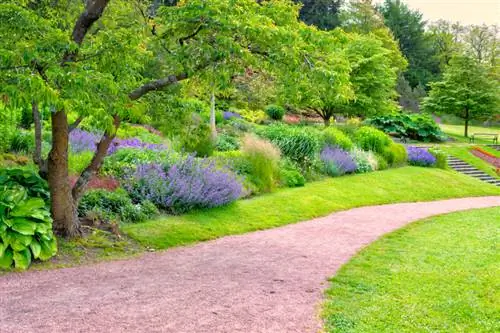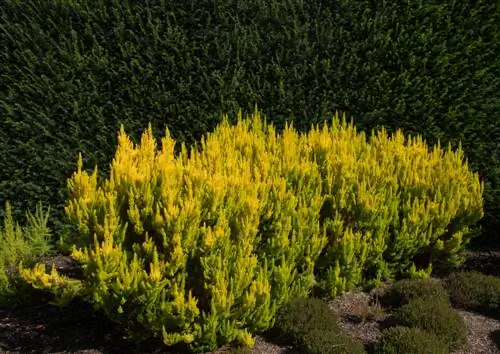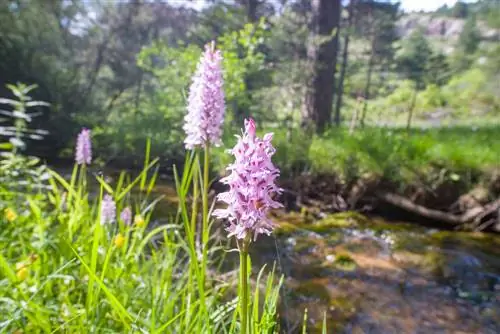- Author admin [email protected].
- Public 2023-12-25 17:45.
- Last modified 2025-06-01 06:02.
The evergreen and undemanding boxwood is an integral part of European garden culture: all the famous park landscapes and palace gardens in different countries are unimaginable without the tree, which is very easy to cut. Whether as a solitary plant, as a hedge or as a topiary: the boxwood has had a strong influence on our idea of a garden as Europeans. The plant is still at home in almost all gardens today, even if cultivation is now proving difficult due to an introduced pest.
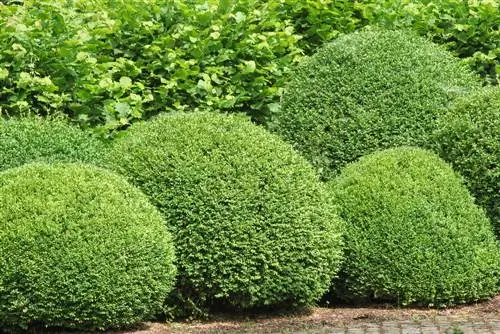
Origin and distribution
The genus boxwood (bot. Buxus) includes around 70 different species that are widespread all over the world. The only native boxwood in Europe is the common boxwood (bot. Buxus sempervirens), which only occurs sporadically in the wild on calcareous soils on sunny, warm mountain slopes in southern Germany. Otherwise, the species is mainly represented in the countries around the Mediterranean.
In addition to the common boxwood, the small-leaved (or Japanese) boxwood (bot. Buxus microphylla) is also of horticultural importance. This species originally comes from Korea and has been cultivated in Japan for many centuries. Both species are quite similar in their appearance as well as in their requirements regarding location and care.
The genus name “Buxus” refers to the former use of the very hard, small-pored wood: Even in ancient times, people made cans and other containers from it, which is why the wood was also called “pyxis” in ancient Greek - i.e. “can”. or “box” - as the ancient Roman writer and scholar Pliny tells us. The light wood is still an important raw material in wood turning today.
Usage
Box is very versatile and can be used as a solitary tree - box trees can grow up to eight meters high - as a hedge or as a topiary for a wide variety of garden designs. Even detailed figures such as animals can be cut from a he althy plant - with the appropriate skill, of course. For formal gardens, rose gardens and cottage gardens - here traditionally primarily as a bed border - the box is practically indispensable.
The European boxwood (bot. Buxus sempervirens) and its vigorous varieties such as 'Handsworthiensis' are particularly suitable for dense and high privacy hedges. The box is also ideal for planting under taller trees and as a frame or background plant for colorful flower and perennial borders. Furthermore, the plant can also be cultivated in larger planters on the balcony or terrace.
Appearance and growth
Both cultivated boxwood species are quite similar in terms of appearance and care, although the common boxwood grows slightly more strongly than its Asian relative. Basically, boxwood is a very slow-growing tree that only gains between ten and 20 centimeters per year. However, under the right conditions, the shrub or small tree can live for several centuries and reach a height of up to eight meters during this time - provided that the tree is allowed to grow freely and is not cut.
Box trees are naturally densely branched and develop a rounded, quite compact crown. On the branches and twigs there are strikingly small, usually rounded and oppositely arranged leaves. These are evergreen, which is why the box remains green even in winter.
Flowering and flowering time
If numerous yellow flowers suddenly appear on your boxwood between the months of March and May, you are witnessing a rare event - boxwood trees only bloom if they are at least ten years old and have been cut little or not at all. In addition, the bloom does not occur every year, as a year with abundant flowering is often followed by one with only a few or no flowers. Flowering boxwood is an important, nectar-rich insect pasture that is busily visited by butterflies, bumblebees, bees and other buzzing garden creatures. Therefore, do not cut back the flowers, anyway - contrary to contrary opinions in some garden forums - the splendor has hardly any influence on the growth of the boxwood.
After flowering, capsule fruits containing seeds develop. However, the formation of the plant's fruits requires a lot of energy, which in turn is actually reflected in significantly slower growth. Therefore, cut the box back after flowering, especially since seed propagation is too complicated for laypeople anyway.
Toxicity
Even if pests such as the dreaded box tree borer prefer to attack the box, the tree is highly toxic to people and pets. There are around 70 different alkaloids in all parts of the plant, of which cyclobuxine is particularly effective. The proportion of this toxin in the leaves and bark of the boxwood is around three percent. Poisoning can be fatal, although this outcome is rare due to the very bitter taste of the plant - no one voluntarily eats more than one sample of it. In addition, the box does not have any tasty-looking flowers or fruits like the yew, which is also very poisonous.
Which location is suitable?
The boxwood feels most comfortable in a sunny to semi-shady and warm location, which, however, should neither be hot nor have too intense sunlight - for example around midday. The box prefers plenty of sun in the morning and evening, while the location is ideally shaded during the hottest time of the day. Therefore, do not necessarily plant the tree directly in front of a bright south-facing wall - leaf damage is inevitable in such a location. But it shouldn't be too shady either, because the boxwood grows poorly if there's a lack of light.read more
Soil / Substrate
If possible, plant the boxwood on loamy, calcareous soil, which you can improve with compost or humus soil when planting if necessary (e.g. if the subsoil is quite sandy). Since boxwood cannot tolerate waterlogging, the soil should be well-drained and loose. For potted specimens, choose commercially available potting soil or compost-based potting soil, as this is less likely to retain water and also protects the peat waste.
Planting boxwood correctly
The optimal planting time for boxwood is spring, on the mildest possible day in April or May. Make sure that you place the box approximately five centimeters deeper in the soil than it was previously in the pot, and the planting distance specified on the label should also be strictly adhered to. Planting too densely only promotes disease and pest infestation. For a hedge, plan on around six to seven specimens per meter, depending on the variety.
And this is how we plant:
- Place the bare root boxwood in a bucket of water.
- This allows the roots to soak up a lot of moisture.
- In the meantime, dig a planting hole.
- This should be at least twice as deep and twice as wide as the circumference of the planter.
- Loose the soil in the planting hole.
- Mix the excavated material with compost.
- Plant the box and press the soil firmly.
- Water the plant.
The soil should be kept evenly, slightly moist until it has grown in (this is shown by the formation of the first green shoots).read more
Watering boxwood
The same watering rules apply to boxwood as to most other garden plants:
- water as early in the morning as possible
- do not water in the evening or midday
- always pour from below and directly onto the ground
- Do not water the leaves (this results in leaf damage and fungal diseases)
- do not use cold water directly from the tap
- better to use rainwater or stale tap water
- do not water when it is frosty
Otherwise, the boxwood is quite insensitive to drought, with two exceptions: Specimens cultivated in pots should not dry out, as this leads to serious damage. Even freshly planted boxwoods need an evenly moist soil until they have grown successfully.read more
Fertilize boxwood properly
Although the boxwood is anything but a heavy feeder, it primarily needs nitrogen for he althy growth. A deficiency is quickly noticeable in brownish discoloration of the leaves. Therefore, both planted boxwood and boxwood grown in containers should be fertilized regularly. The best options for this are
- Compost and horn shavings: between April and September, three liters of compost and one tablespoon of horn shavings per square meter of planting area every three to four weeks
- Box tree fertilizer or green plant fertilizer: according to package instructions and after a previous soil analysis
- Patentpotash: in August to harden the trees for the winter
Blue grain is less suitable for fertilization, as the product for boxwood has the wrong nutrient composition and therefore leads to deficiency symptoms.read more
Cut boxwood correctly
The popularity of the boxwood is primarily explained by its tolerance to pruning: the plant tolerates any form of pruning and should generally be pruned at least twice a year. The stronger-growing varieties in particular branch better and have a nice, dense growth. Topiary trees in particular - boxwood can be easily cut into detailed figures such as spirals and animals, but also into simple geometric shapes such as balls, cones or cubes - require scissors between one and five times a year. The specific frequency is measured by the growth rate of the boxwood variety and the we alth of detail of the figure. In principle, the box tolerates pruning deep into the perennial wood very well.read more
Propagate boxwood
The easiest way to propagate boxwood is through so-called cracklings. These are cuttings that are not separated from the mother plant with a knife, but are instead carefully torn off. A piece of bark remains at the crack, which you shorten slightly with a strong knife before planting. The best time for this form of propagation is the months of July and August. The next steps are:
- Separate cracklings from the mother plant
- optimal length between 20 and 30 centimeters
- Cut off any excess bark strips
- Cut back the shoot at the top by a third
- remove lower leaves
- Plant cuttings directly in the garden
- protected pot culture not necessary
- choose a partially shaded, protected location
- Soil should be loamy, loose and rich in humus
- Leaves must not touch soil
- Keep soil moist
- cover with brushwood in winter
It can take up to six months for the young cuttings to form their first roots. As a rule, with the procedure described above, the young plants are rooted by next spring.read more
Wintering
Box trees are hardy enough, but they also need water in winter because of their evergreen leaves. Potted plants in particular should be watered regularly to compensate for evaporated moisture. Water the plants in mild, frost-free weather and especially when the sun is shining.
Speaking of the sun: The combination of “frosty cold” and “bright sunshine” quickly leads to frost damage to leaves and shoots. It therefore makes sense to cover the plants with fleece when the weather is appropriate. Specimens grown in pots, on the other hand, can simply be placed in a semi-shady place.
By the way: Although pot box bushes can also be left outside during the winter months, they must be protected from freezing of the substrate and thus the roots. To do this, place the planter on a wooden or Styrofoam base and wrap it with an insulating but air-permeable material. For example, jute bags, bamboo mats or special gardening fleece are ideal.read more
Diseases
Unfortunately, the boxwood is a plant that is very sensitive to diseases and is particularly threatened by various fungal diseases as a result of care or location errors. These mainly occur when the planting is too close or when the ground is wet. If you have discovered one of the diseases described in the following section on your book, you should immediately cut out all diseased shoots deep into the he althy wood and dispose of them with household waste. Under no circumstances should you throw infected material into the compost to prevent further spread.
The most common boxwood diseases:
- Shoot death (pathogen: Cylidrocladium buxicola)
- Boxwood cancer (pathogen: Volutella buxi): yellow to dark leaf spots, leaves dry and are shed, pink spores on the underside of the leaves, cracks in the bark
- Boxwood wilt (pathogen: Fusarium buxicola): leaves become brown, leathery and dry, dark brown spore deposits on the underside of the leaves
Shoot death (Cylindrocladium buxicola)
The boxwood is particularly at risk from the fungus Cylindrocladium buxicola, which causes the dreaded shoot death. The pathogen enters the plant through the leaves, especially after long periods of rain, and causes them to gradually die after an infection. You can recognize an infection by the following signs:
- dark brown to black spots on leaves and shoots
- Leaf spots gradually spread
- white spore deposits form on the undersides of the leaves
- affected shoots and leaves dry up
- As the disease progresses, the entire plant dies
The only thing that helps against the disease is a strong pruning deep into the he althy wood. If the plant dies, you should no longer plant new box trees in the area in question, as the pathogen remains in the soil via its spores for many years and also infects new box trees.
The risk of infection can be minimized if you avoid pruning in rainy or damp weather. The cuts create new entry gates that allow the fungus to enter the previously he althy boxwood.read more
Pests
Apart from fungal diseases, the boxwood is also threatened by a number of pests, primarily the boxwood borer, which has been appearing increasingly in recent years and is destroying entire populations. Spider mites, gall midges and boxwood flea do not cause half as much damage and are also easier to control.
Box tree moth (Cydalima perspectalis)
This is a pest introduced through imports from Asia, whose caterpillars defoliate entire stands of books within a short period of time due to their mass appearance and feeding behavior. Depending on their stage of development, the boxwood moth caterpillars are between eight millimeters and five centimeters long and can be easily recognized by their green base color with the light-dark longitudinal stripes and their black head. The adult butterfly, on the other hand, is quite small and has light-colored wings with a brownish edge. It only lives for a few days, during which it always stays near box plants and lays its eggs there.
The caterpillars overwinter in the woods and begin their feeding activity quite early in the year: each of the small animals eats around 45 boxwood leaves, which doesn't sound like much at first. However, they often appear in hundreds to thousands of specimens, so that the box is quickly eaten bare. You often only recognize an infestation when the affected plants are already brown and leafless, as the caterpillars hide in white webs inside the dense wood.
Measures against the boxwood borer:
- Collect caterpillars and pupae
- Setting up scent traps for adult butterflies
- cut back affected areas heavily
- Sprinkle boxwood with rock dust or algae lime as a precaution in spring
- Use biological insecticides if there is a heavy infestation
Tip
If you live in a region with an increased incidence of boxwood borer and/or shoot dieback, the following alternatives for the garden make more sense instead of boxwood: embankment myrtle (Lonicera pileata), hedge myrtle (Lonicera nitida 'Elegant'), mountain myrtle. Ilex (Ilex crenata 'Glorie Gem'), low mountain Ilex (Ilex crenata 'Stokes') or for borders Ilex aquifolium 'Heckenzwerg'. The best alternative to box so far is the new variety Rhododendron micranthum 'Bloombux'.
Species and varieties
The following two boxwood species and their varieties have proven particularly suitable for planting in ornamental gardens.
Common boxwood (bot. Buxus sempervirens)
The common boxwood has been known for thousands of years - and was highly valued in prehistoric times because of its extremely hard wood. In the graves of Neanderthals, researchers sometimes found grave goods in the form of grave sticks made of boxwood wood. The native species is also very popular as a garden plant and was already found in gardens in ancient Rome. Due to its very long cultural history, around 60 different varieties of the species have now been developed, some of which have different characteristics. We present the most beautiful ones for your home garden here:
- 'Angustifolia': compact but comparatively fast-growing variety with attractive, dark green foliage
- 'Arborescens': for topiaries and hedges, can grow into a tree with age
- 'Aurea': the variety impresses with golden yellow foliage
- 'Aureo-variegata': beautiful, robust variety for larger bushes, large, white variegated leaves
- 'Blauer Heinz': proven, very low variety with a maximum height of 60 centimeters and beautiful, blue-green foliage
- 'Elegantissima': attractive two-tone foliage, variety forms dark green leaves with a white edge
- 'Green Gem': robust, very low variety with a maximum height of 80 centimeters
- 'Handsworthiens': robust, tall variety with growth heights of up to three meters, perfect for privacy hedges
- 'Marginata': tall growing variety for privacy hedges with attractive, yellow-edged foliage
- 'Rotundifolia': robust, tall growth with heights of up to four meters and beautiful, dark green foliage
- 'Suffruticosa': tried and tested variety for bed borders, only grows up to one meter high
Small-leaved boxwood (bot. Buxus microphylla)
The small-leaved boxwood is particularly widespread in Korea and Japan and is traditionally part of the characteristic planting of a Japanese garden. The species grows weaker than the common European boxwood, but is less sensitive to the dreaded fungus Cylindrocladium buxicola. On the German market the species is available in two varieties:
- 'Faulkner': beautiful variety with a natural spherical shape, grows up to two meters high and just as wide
- 'Herrenhausen': proven, low variety with a maximum height of 60 centimeters and beautiful, dark green foliage

